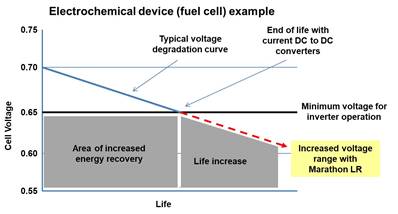The Challenge
A persistent challenge to renewable generation systems, whether solar, wind, fuel cell or energy storage has been the efficient collection of energy as output voltage drops e.g. reduced sunlight on the solar cell, discharge of a battery/capacitor or aging of a fuel cell stack.
Now for the first time there is a power electronics solution matched to the performance characteristics of variable low voltage DC sources – Marathon LR.
With the unique ability to efficiently boost variable low voltage input to high-quality, high voltage output our Marathon LR interleaves multiple parallel dc-dc converters to lower the RMS switching currents, distribute dissipated heat and enable soft switching capabilities. The result is a DC-DC converter that increases its boost efficiency as the input voltage drops.
The input currents of the multiple phases sum, while switching multiplies to give high current capability and an effective switching frequency many times higher than in a single-phase configuration. This high-frequency switching allows for the minimization of the devices inductors and capacitors, lowering cost and size while increasing reliability.
Benefits of this average current control method are infinite DC gain, better control of inductor current and immunity to noise.
Click here to view our 10kW and 30kW spec sheet. <HERE>

Fuel Cell Systems
Historically, fuel cell systems have relied on power electronics developed for the solar industry. The solar industry inverters are mature, commercially available and have the appropriate certifications for residential and light commercial use. They are, however, designed for the solar arrays’ high voltage DC input (200 – 450 VDC) and their efficiency is strongly dependent upon input voltage; the lower the input voltage the less efficient the power conversion.
In contrast fuel cells produce low voltage, high current, unregulated DC power that is relatively incompatible with commercially available solar inverters. Marathon LR technology bridges between the unique characteristics of the fuel cell and the standard interface of a commercial inverter.
Energy Storage
Battery systems are comprised of multiple individual cells combined in strings to achieve a specific aggregated voltage output, whilst the active area (cross section) of the battery determines the energy storage (amp-hrs) capability. Battery solution providers constantly find themselves balancing the inherent pros and cons between the number and size of cells for a specific application.
Where the greatest historic tension has risen is between the inverter preference for high dc-voltage so it can achieve high conversion efficiency (requiring a large number of individual battery cells) and the battery desire for a few large cells so it will be cost effective, long-lived, reliable and easy to site/maintain.
Marathon LR offers a breakthrough in this paradigm by efficiently and effectively providing a bridge between the battery and inverter technologies allowing providers to source a smaller quantity of high amp-hr batteries and still take advantage of high efficiency inverters.









Social Contact